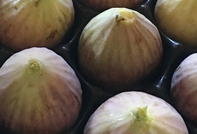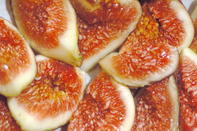Part of a genus of between 750 and 800 recorded species, the ‘eating fig’, Ficus carica, is unique.

The rest of the genus are mostly tropical ‘rubber’ trees with inedible fruit. The world’s biggest producer of fresh and dried figs is Turkey, but South Africa also produces fresh figs for export, about 0.12% of the world’s production.
Taste of Figs

Depending on the fig variety, figs can be classified into three basic flavours - berry, honey, and sugar (plain). The colour of the fig flesh has more to do with the flavour of the fig than the colour of its skin.
‘Sugar’ figs tend to have amber or brown-coloured flesh while ‘berry’ figs have red to purple pulp. ‘Honey’ figs usually have light skins with yellow flesh.
Uses of Figs

Figs are mostly eaten fresh - with or without skins. Figs used in cooking, are added to salads and desserts, combined with yoghurt for breakfast or with cheeses for cheese platters. They are often dressed with brandy, rum and liqueurs or balsamic vinegar and honey, but low-grade figs can also be used to distil alcohol.
Breba or early season figs are mostly used for preserving - to prepare a popular ‘green fig’ jam. Figs can be successfully combined with granadillas, used in chutney and salad dressings and preserved in brandy.
Figs may also be dried but most dried figs available in South Africa are imported from Turkey. Figs are also processed into dried fruit rolls.
It is also said that dried figs can be roasted and brewed as a coffee substitute and that an edible oil can be extracted from fig seeds.
The fragrant fig leaves are used in cooking, mostly as a wrap to bake or steam ingredients. It imparts a smoky fruity flavour and coconut aroma. Fig leaf syrup is used for glazing meat, in cocktail mixes and in jellies.
Benefits of Figs
Figs contain dietary fibre, vitamin B6, magnesium, potassium, calcium, manganese and antioxidants, especially the purple varieties.
Fig leaves and the white milky ‘fig sap’ are proposed to have medicinal benefits such as lowering blood sugar levels and blood pressure and may have anti-cancer properties. Fig leaves can also be used to make a tea to treat bronchitis.
Scientific studies have also shown figs are effective at treating a variety of skin conditions including warts. Eating fresh figs is believed to have a laxative effect as well.
Please note: Information is for educational and informational purposes only and may not be construed as medical advice. The information is not intended to replace medical advice or treatment offered by healthcare professionals.
By Marinda Louw